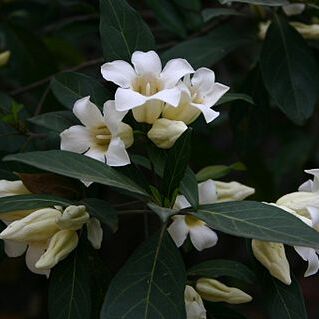Unarmed shrubs or small trees. Leaves opposite or occasionally ternate, petiolate, with or without domatia; stipules triangular, ± acuminate. Flowers hermaphrodite, terminal, on very reduced branches, usually above a single leaf, sessile or shortly pedicellate or pedunculate, solitary or less often cymose, large or very large, often pendent. Calyx-tube usually turbinate to cylindrical; limb-tube velvety inside, often with colleters interspersed; lobes present or absent, erect. Corolla mostly white with coloured spots; narrowly to distinctly funnel-shaped or campanulate; lobes 5 (or in one species 7–8), contorted, overlapping either to the right or to the left according to the species. Stamens with anthers included or partly exserted; pollen grains simple. Ovary 1-locular, with 2 parietal placentas opposite to each other and sometimes partially fused; ovules very numerous; style glabrous subulate; stigma consisting of the usually club-shaped pollen receptacle with the stigmatic surface confined to the shortly bilobed apex. Fruit globular or ellipsoid, smooth or grooved, usually large, sometimes crowned with the persistent calyx-limb; pericarp thick or coriaceous. Seeds very numerous, sublenticular, 0.5–1.2 cm. long, embedded in the pulpy placental tissue and forming a solid mass.
Ovary 1-locular with 2 parietal placentas opposite to each other and sometimes partially fused; ovules very numerous; style glabrous subulate; pollen presenter usually large with the stigmatic surface confined to the shortly bilobed apex included or exserted.
Flowers hermaphrodite, terminal on reduced branches very often borne above a single leaf (TAB. 75/3&4), sessile or shortly pedicellate, pedunculate or not, solitary or less often 2–17, large or very large, often pendent.
Corolla mostly white with coloured spots; narrowly to distinctly funnel-shaped or campanulate; lobes 5 (or 7–8, not in the Flora area) contorted, overlapping either to the right or to the left according to the species.
Fruit globular or ellipsoid, smooth or ribbed, usually large sometimes crowned with the persistent calyx limb; pericarp thick or coriaceous.
Calyx tube usually turbinate to cylindrical; limb-tube velvety inside, often with colleters interspersed; lobes present or absent, erect.
Leaves opposite but can appear ternate at fertile nodes, with or without domatia, petiolate; stipule limbs triangular, ± acuminate.
Seeds very numerous, sublenticular, embedded in the pulpy placental tissue and forming a solid mass.
Stamens with anthers included or partly exserted.
Unarmed shrubs or small trees.
Pollen grains simple.

